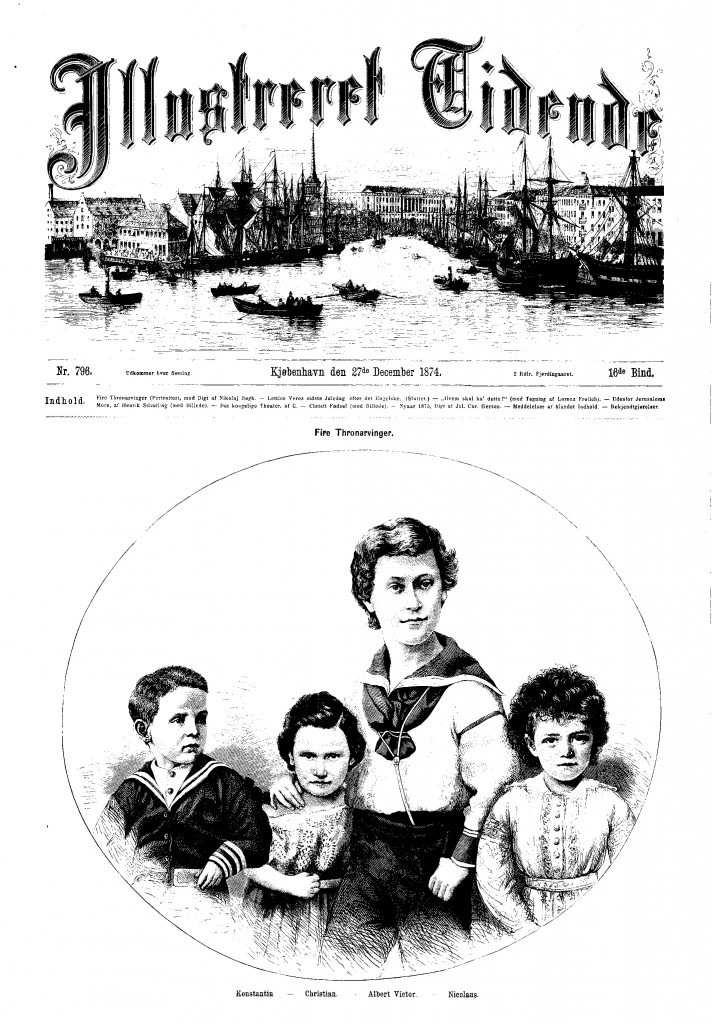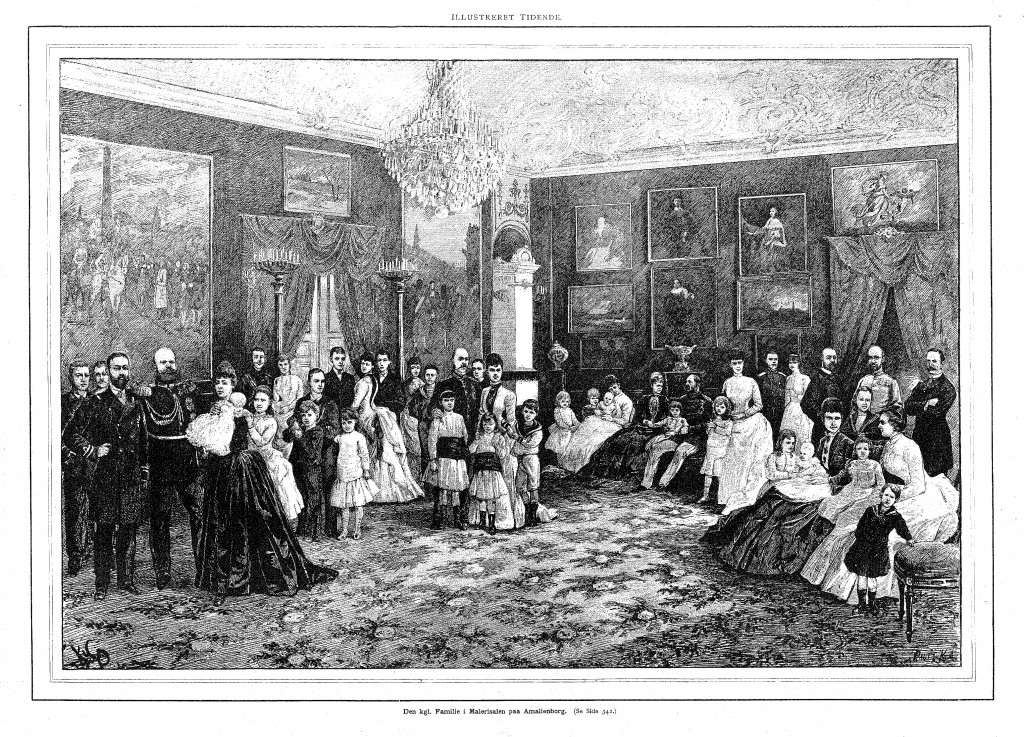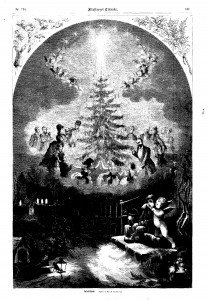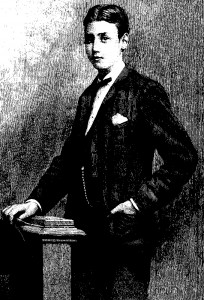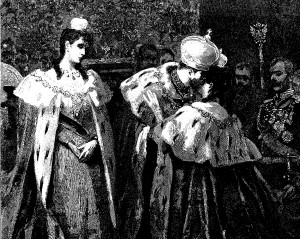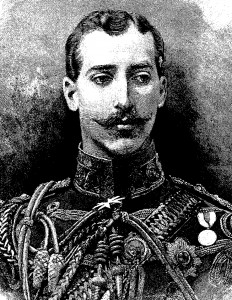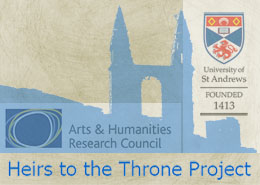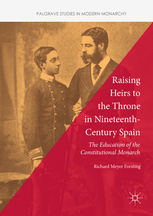See also: A tale of two princes
“Our four heirs to the throne”: Emotional identification with the success
of the Glücksborg dynasty in 19th-century Danish family magazines
Miriam Schneider
On 27 December 1874, the Christmas edition of the Danish illustrated weekly “Illustreret Tidende” featured as its cover illustration a charming group portrait: it depicted four chubby-cheeked children ranging from the age of ten to four, wearing sailor suits and baby gowns according to contemporary fashion. The boys, led by a confident-looking teen, were named Albert Victor, Konstantin, Nicolaus, and Christian and as the caption revealed, they were “Four heirs to the throne” (Fire Thronarvinger).
Turning over the page, one would be able to read a sentimental Christmas poem by the popular Hans-Christian-Andersen-confidant Nicolai Bøgh which was to serve as a Seasons’ greeting (Julehilsen) to the four boys. Picture and poem can be interpreted as illustrations of the emotional relationship that developed between the young Danish dynasty of Schleswig-Holstein-Sonderborg-Glücksborg and the people of Denmark in the second half of the nineteenth century.
 The poem described the European reach of the Glücksborg dynasty in poetic terms. From their ancient shores, the Danish people sent their Seasons’ greetings to the children living in the royal halls of Britain, among the laurel trees on Hellas’ coast, and under the fir trees of Russia’s winter hibernation. Their addressees were the eldest sons of the four eldest children of King Christian IX (also known as the “Father-in-law of Europe”) – four boys who were all destined to become reigning sovereigns one day:
The poem described the European reach of the Glücksborg dynasty in poetic terms. From their ancient shores, the Danish people sent their Seasons’ greetings to the children living in the royal halls of Britain, among the laurel trees on Hellas’ coast, and under the fir trees of Russia’s winter hibernation. Their addressees were the eldest sons of the four eldest children of King Christian IX (also known as the “Father-in-law of Europe”) – four boys who were all destined to become reigning sovereigns one day:
Albert Victor (1864-1892), the confident teen on the picture, was the firstborn of Princess Alexandra of Denmark, who had wed Albert Edward Prince of Wales in 1863. Her marriage had aligned her small and vulnerable mother-country with the mightiest power of the age, a protector, as it was seen back then, against the potential aggression of Prussia-Germany.
Konstantin (1868-1923, the future Constantine I), the little sailor suit, was the heir-to-the-throne of King George I of Greece, formerly Prince Vilhelm of Denmark, who had been elected to the throne of the first of many newly-emerging nation-states in the Balkans in 1863.
Nicolaus (1868-1917, the future Nicholas II), the curly-haired boy on the right, was the eldest son of Tsarevna Maria Feodorovna of Russia, née Princess Dagmar of Denmark. Her marriage to Tsarevich Alexander (III) in 1866 had allied the naval power Denmark with the then dominant power of the Baltic Sea region.
The shy-looking Christian (1870-1947, the future Christian X), finally, was the firstborn of Crown Prince Frederick of Denmark and his wife, Louise of Sweden. Their wedding had represented a kind of reconciliation between two rivalling countries, and it was perceived by many as a harbinger of a potential future Scandinavian Union.
Together, the four princes epitomized the fairytale success of the Glücksborg dynasty. It had all started in 1853, when Prince Christian of Glücksborg, a poor younger son of one of the many ducal houses of Schleswig-Holstein, and his wife Louise, née Princess of Hesse-Kassel, were established as heirs to the soon to-be-vacant throne of the Kingdom of Denmark. While their predecessors had caused the extinction of the main branch of the family by failing to produce sufficient offspring, Christian and Louise’s dynastic marriage had combined the claims of two remote side branches of the Danish royal house. Even before they ascended the throne upon the death of King Frederick VII in 1863, the couple continued the dynastic marriage policy, which had already earned them a kingdom, by marrying their own numerous pretty daughters and handsome sons into the most powerful royal houses of Europe. By following the demands of Danish security policy, they hoped to complete their main task of safeguarding the territorial integrity of the Danish Monarchy, a conglomerate state consisting of disparate components with varying succession rights (the core Denmark, the duchies Schleswig, Holstein and Lauenburg, the provinces Iceland and the Faroe Islands, as well as the colonies Greenland and the Danish West Indies).
As Jes Fabricius Møllerhas only recently stressed in “Dynastiet Glücksborg”, however, this marriage policy was to no avail. Within a year of Christian IX’s succession, war broke out between Denmark and the executive powers of the German Federation over the Schleswig-Holstein question. The conflict, which pitted against each other the liberal national movements that had emerged in both core Denmark and in the duchies, ended with a Danish defeat and the loss of a substantial part of territory which reduced Denmark to small-power status. Although British public opinion favoured the Danes, neither Britain nor Russia would intervene in 1864, and for the rest of the century, the tiny nation-state would grapple with its reduced role in the mounting shadow of the German Empire, without receiving from its dynastic connections any material gains in the shape of active political or military support. With dynastic legitimacy fading into the background, the German-born Christian IX (who, in the words of Herman Bang’s novel “Tine”, had “no Danish heart in his breast”) suddenly faced the challenge of “nationalizing” his dynasty and of becoming the representative of a newly-formed nation-state and newly-negotiated national identity. Scholars agree that, over the next few decades, the Glücksborgs were remarkably successful in gaining popularity, despite King Christian’s prolonged support of conservative minority governments. But the question remains, how their transnational dynasty managed to transform itself into an emotionally invested epitome of Denmark.
Here as well, our “Four heirs to the throne” provide an intriguing answer. For they encapsulate the blend of ancient, dynastic and modern, “domesticated” features that characterized many popular European monarchies in the second half of the nineteenth century.
In this period, the representation, public perception, and increasingly also self-understanding of dynasties changed: from transnationally acting, state-defining formations of relatives in the pursuit of power to de-politicized units seemingly adopting the middle-class values and domestic tastes of tightly-knit, emotionally attached nuclear families. In tune with this trend, the carefully designed Glücksborg dynasty was transformed, almost overnight, into the first family of a miniature nation-state. Their close family structure and public accessibility in Copenhagen’s bijou society lent themselves to emotional identification.
The four princes featured on the cover of Illustreret Tidende had been conceived according to an ancient dynastic logic, and they would further the influence of their dynasty by becoming reigning sovereigns of some of the major powers of Europe. But in an age of contested monarchical power and nationalization, their relationship was depicted as that of little cousins, devoted to each other in a middle-class fashion. The accompanying poem evoked feelings of innocent child’s joy and laughter (Barneglæde) with which the bourgeois readers of Illustreret Tidende could easily identify. Moreover, the boys were imagined in a Christmas setting spanning Europe, a gigantic celebration of the domestic, Christian values epitomized by 19th-century family magazines. The projected image of diverse families gathering round a festively decorated fir tree (Om Juletræets Stjerne) reflected Danish-German Christmas culture and assumed a uniformity of tradition uniting East and West which might even have been an export success of the Danish Royal Family.
Far from being a-political, however, the poem had a clear vision of the destiny awaiting the four princes, wishing them to grow up into wise men and strong, but liberal-minded monarchs (med Friheds Sind og Sværd ved Lænd) worthy of their Danish progenitors (Danmarks Kongestamme). In this final twist, the dynasty turned family was claimed as a symbol of its people; the four crown princes were imagined not as scions of a young, transnational dynasty, but as children of Denmark; and the success of the dynasty was re-interpreted as the success of the nation.
The Glücksborgs, a small royal family which, within one generation, managed to become a legitimate and prominent member of the European family of dynasties, were characterised by a clever dynastic policy, a strong family-sense celebrated in constant family re-unions, and a remarkable devotion to tiny Denmark, which resulted in typically split national identities and (mainly futile) behind-the-scenes political maneuvering on the part of its transplanted members.
Danish publics were closely acquainted with all of King Christian IX’s children, and the Danish “boulevard press” would follow their lives abroad almost as closely as at home, glossing over any issues which the political press might have with them. While national security policy had to come to terms with the fact that no help was to be expected from anywhere, vulnerable and neglected Denmark nevertheless took pride in and gained new confidence from the prestige and soft power advantages attached to royal family relations.
Especially in the private (international) business sector, Danish enterprises such as Great Northern Telegraph or East Asiatic Company would benefit from the small-power niche inhabited by a country which could hardly be called a rival to anyone. And they profited from the diplomatic and economic guardianship of benevolent powers such as Russia and Britain. The participation, both real and imagined, in the wide world of big politics opened to the Danish public via identification with the successful Glücksborg dynasty, offered a break from the provincialism it had been confined to in 1864.

Crown Prince Constantine of Greece and Princess Sophia of Prussia, Illustreret Tidende, 20 October 1889
From 1874 onwards, Illustreret Tidende would also take increased interest and pride in, nay lay claim to the third generation of the Glücksborg dynasty epitomized in our “Four heirs to the throne”. It would report regularly on the various rites of passage and family events taking place in the lives of the well-known future monarchs of Britain, Russia, Denmark and Greece, four youths who were united by their common origin and strong family bonds, but divided by their roles as first “natives” of increasingly nationalized individual dynasties and by the power conflicts fought out by their countries.
They would return to the cover of Illustreret Tidende on selected birthdays, like sweet-sixteen-year-old Prince Christian in October 1886. Their weddings were high points of media interest, e. g. when Prince Constantine married Princess Sophie of Prussia in October 1889. Greatest attention was paid to them when they succeeded to the throne, as Nicholas II did at a remarkably young age in 1895. And their lives were trailed unto the bitter end, which Prince Albert Victor, the confident teen on the cover, reached in 1892 – long before he could grow up to become the wise man and monarch prayed and wished for in the 1874 Christmas edition.
Further reading:
Møller, Jes Fabricius, Dynastiet Glücksborg: En Danmarkshistorie (Copenhagen, 2013)
Møller, Jes Fabricius, Domesticating a Nineteenth-Century Dynasty: A German Successor to the Danish Throne, in: Mehrkens, Heidi/Müller, Frank Lorenz (eds.), Sons and Heirs. Dynasty and Political Culture in 19th-Century Europe (forthcoming)
Schama, Simon, ‘The Domestication of Majesty: Royal Family Portraiture, 1500-1850’, The Journal of Interdisciplinary History, 17 (1986), 155–183
Sevaldsen, Jørgen et al. (eds.), Britain and Denmark: Political, Economic and Cultural Relations in the19th and 20th Centuries (Aarhus, 2010)
Petri, Gerda, Forbindelserne mellem det danske og det russiske hof i det 19. århundrede, in: Christensen, Svend/Henning, Gottlieb, Danmark og Rusland i 500 år (Copenhagen, 1993)
All images in this article: Royal Library, Copenhagen

